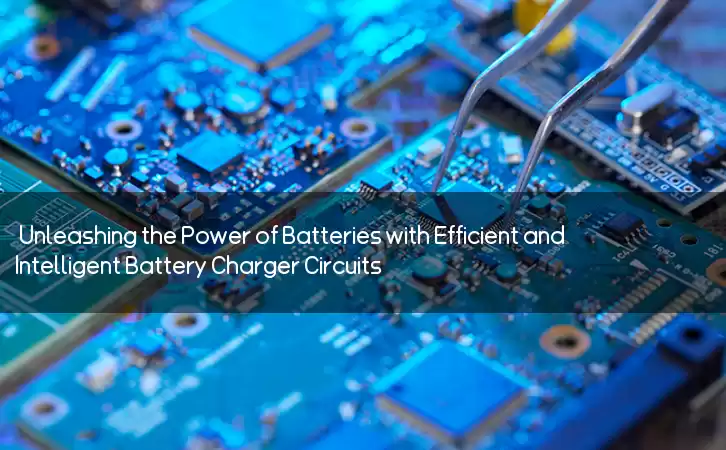Information Center
Unleashing the Power of Batteries with Efficient and Intelligent Battery Charger Circuits
Published:2023-06-16 00:38:17 Author:Green WCND Views:48Battery Charger Circuit: An Important Component for Efficient Charging of Batteries

Battery technology has advanced tremendously in recent years, providing more efficient, long-lasting, high-capacity, and cost-effective batteries. However, the importance of an efficient battery charger circuit cannot be overlooked. A battery charger circuit is responsible for providing the right amount of current, voltage, and duration to the battery to ensure that it charges properly, lasts longer, and operates safely. In this article, we will discuss the basics of battery charger circuit design, its key components, and its types.

Basics of Battery Charger Circuit Design

Before designing a battery charger circuit, it is crucial to understand the charging process and the properties of the battery being charged. The charging process involves three stages: bulk charging, absorption charging, and float charging. The bulk charging stage provides a high charging current to the depleted battery until its voltage reaches a predefined level. At this point, the absorption charging stage begins, which provides a lower charging current to the battery while maintaining its voltage at a constant level until it is fully charged. Finally, the float charging stage provides a low charging current to the fully charged battery to maintain its voltage at a safe level without overcharging it.
The key parameters that affect the charging process and the performance of the battery charger circuit include the current rating, voltage rating, charging time, charge termination criteria, temperature dependence, and safety features. Therefore, it is essential to choose the right components, such as the power source, rectifier, regulator, control logic, and safety features, depending on the battery type and application.
Key Components of Battery Charger Circuit
1. Power Source
The power source provides the input power for the charger circuit. Depending on the application and the battery type, the power source can be AC mains, DC source, solar panel, or a combination of them.
2. Rectifier
The rectifier converts the AC input power into DC power that can be used for charging the battery. Depending on the power source and the battery type, the rectifier can be a diode bridge, a full-wave rectifier, or a half-wave rectifier.
3. Regulator
The regulator maintains the output voltage and current within the desired range to ensure proper charging of the battery. Depending on the charging process and the battery type, the regulator can be a linear regulator, a switching regulator, or a smart regulator.
4. Control Logic
The control logic provides the intelligence for the charger circuit by controlling the charging sequence, monitoring the battery status, and regulating the output voltage and current. Depending on the complexity and features of the charger circuit, the control logic can be implemented using discrete components, microcontrollers, or programmable logic devices.
5. Safety Features
The safety features protect the battery and the charger circuit from overcharging, overvoltage, overcurrent, and overheating. Depending on the battery type and the application, the safety features can include voltage and current sensors, temperature sensors, fuses, and protection circuits.
Types of Battery Charger Circuit
1. Linear Charger
A linear charger uses a linear regulator to provide a constant voltage or current to the battery. Linear chargers are simple, low-cost, and easy to design, but they are less efficient, generate more heat, and have limited features and flexibility. Linear chargers are suitable for low-capacity batteries and low-power applications.
2. Switching Charger
A switching charger uses a switching regulator to provide a high-frequency pulse of current to the battery, which is more efficient, less heat, and more flexible than the linear regulator. Switching chargers are more complex and expensive than linear chargers and require careful design to avoid noise and interference. Switching chargers are suitable for high-capacity batteries and high-power applications.
3. Smart Charger
A smart charger uses a microcontroller or a programmable logic device to control the charging sequence, monitor the battery status, and adjust the output voltage and current according to the battery specifications. Smart chargers are more intelligent, versatile, and efficient than linear and switching chargers and can accommodate multiple battery types and charging algorithms. Smart chargers are suitable for all types of batteries and applications, but they are more complex and expensive than linear and switching chargers.
Conclusion
In conclusion, a battery charger circuit is an essential component for efficient and safe charging of batteries. The choice of the right components, the proper design, and the appropriate safety features can significantly affect the performance, reliability, and lifespan of the battery charger circuit. Therefore, it is crucial to understand the basics of battery charging, the properties of the battery, and the requirements of the application before designing a battery charger circuit.
Handheld Vacuum Cleaner Power Adapter Selection GuideIntroductionHandheld vacuum cleaners have become a mainstream tool for household cleaning due to their port···
Drill Power Adapter Selection Guide.drill-container { font-family: Arial, sans-serif; line-height: 1.6; max-width: 800px; margin: 0 auto; padding: 20px; } .dril···
As a manufacturer dedicated to providing high-quality kitchen appliances, choosing the right power adapter for your rice cooker is crucial to ensuring product s···
As a manufacturer of all-in-one desktop PCs, the power adapter serves as the "invisible guardian" of stable device operation. It must not only precise···





